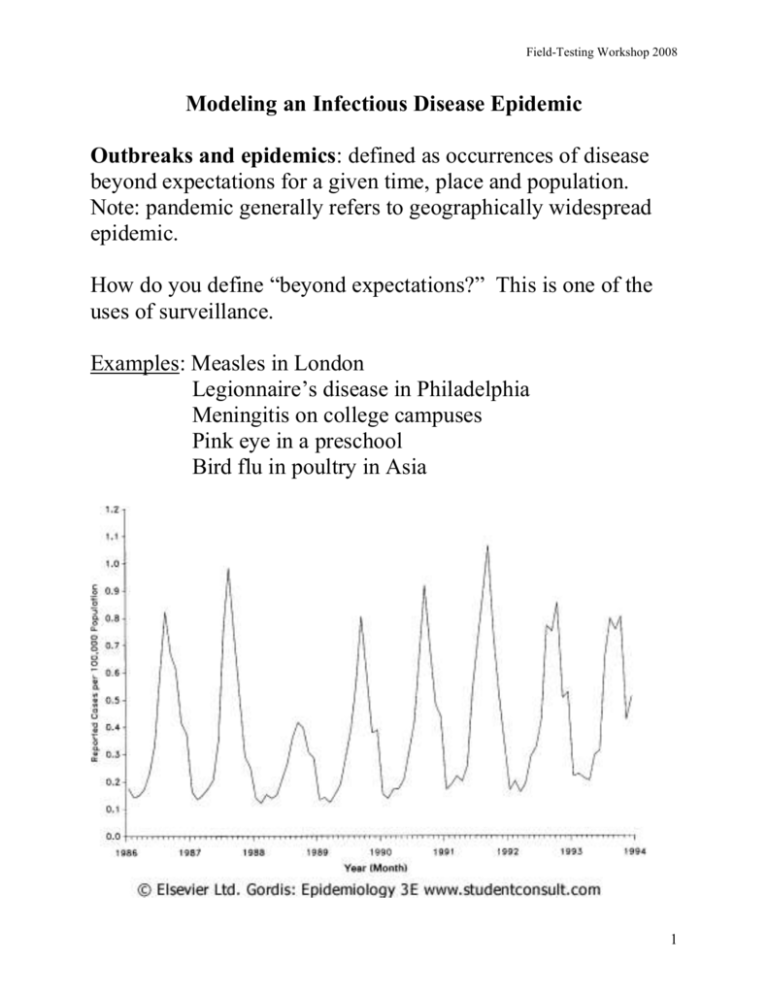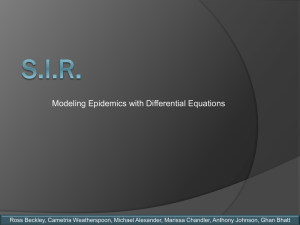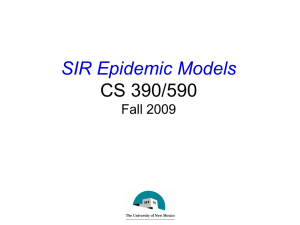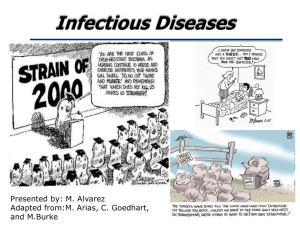Modeling Infectious Disease Epidemic (#4 for week, 1
advertisement

Field-Testing Workshop 2008 Modeling an Infectious Disease Epidemic Outbreaks and epidemics: defined as occurrences of disease beyond expectations for a given time, place and population. Note: pandemic generally refers to geographically widespread epidemic. How do you define “beyond expectations?” This is one of the uses of surveillance. Examples: Measles in London Legionnaire’s disease in Philadelphia Meningitis on college campuses Pink eye in a preschool Bird flu in poultry in Asia 1 Field-Testing Workshop 2008 Scientific questions we might want to ask about infectious disease spread and epidemics Will a given disease become epidemic? How far will it spread? How many individuals (or what proportion) will become infected? How long will the disease persist in the population? Would vaccination prevent an epidemic? If so, what type of vaccination program is most efficient? What other measures could be taken to prevent an epidemic? Basic Reproductive Number, R0 Whether or not an epidemic occurs depends on many factors. A very simple and useful parameter for modeling the potential for an epidemic is the potential for a contagious disease to spread through a population. We call the average number of individuals directly infected by an infected case during his or her entire infectious period after entering a totally susceptible population the Basic Reproductive Number, R0. 2 Field-Testing Workshop 2008 Activity: Calculate R0 for the figure. Based on the figure and what you know about real populations, what part of the definition of R0 is problematic for estimating R0 like we did? 3 Field-Testing Workshop 2008 Components of R0 R0 = x x D is the risk of transmission per contact is the number of such contacts that an average person in the population has per some unit of time D is the average duration of infectivity for an infected person Note: and D should be measured in the same units of time Example: A preschool child comes into contact with 20 kids per day on average. If the risk of transmitting pink eye per contact is .80 and duration of disease is 7 days, what is R0 for pink eye in a preschool? Each of these components represents a potential route of intervention in the spread of the infection or disease in the population. 4 Field-Testing Workshop 2008 R0 necessary for epidemic to occur Assume that R0 = 2, so that each infected person infects 2 other people before they are no longer infected. Also assume that the infections occur in “waves” so that we can keep track of how many people are infected more simply. Consider the following: 1 2 3 4 How many people are infected after each wave? Wave 1 2 3 4 5 6 Number infected At each wave, more individuals are infected than in the previous wave. What is the formula for determining how many individuals are infected after each wave? 5 Field-Testing Workshop 2008 Number affected after wave n = What if R0 = 3? Number affected after wave n = 6 Field-Testing Workshop 2008 What value must R0 be to maintain a constant number of infected individuals in the population? R0 = When the number of infected (sick) individuals in the population is constant over time, we say the infection (disease) is endemic. What value(s) of R0 do we require to have the infection eventually disappear from the population? R0 Why? Summary of implications of R0: If R0 < 1 then If R0 = 1 then If R0 > 1 then 7 Field-Testing Workshop 2008 Vaccination level required to prevent epidemic As you learned in the tutorial, vaccination can provide protection from infection for those who have been successfully vaccinated. What component of R0 will this affect? Example: Assume that R0 = 4 for a disease in the absence of vaccination, with probability of transmission=.40, average number of contacts per day = 5 , and average duration of disease = 2 days. What happens to the probability of transmission, , (and therefore R0) if we assume that ¼ of the population has been vaccinated? Hence, in the vaccinated population = in the unvaccinated population –. In addition, R0 in the vaccinated population = Note: R0 in the vaccinated population = R0 in the unvaccinated population 8 Field-Testing Workshop 2008 What level of vaccination do we require to prevent an epidemic? We want R0 in the vaccinated population to be less than 1. Let’s call the unknown proportion of vaccinated individuals V. We want If we achieve a level of vaccination that satisfies the above in a given population, we say that the population has achieved herd immunity. Example continued: For our above example, R0 = 4, and so we require V > ? We would need to vaccinate at least ? of the population to prevent an epidemic for a disease with R0 = 4. 9 Field-Testing Workshop 2008 Other ways to reduce R0 Note that we can get the same reduction in R0 by reducing any 1 of the 3 components of R0 by more than 1 - R . 0 10








